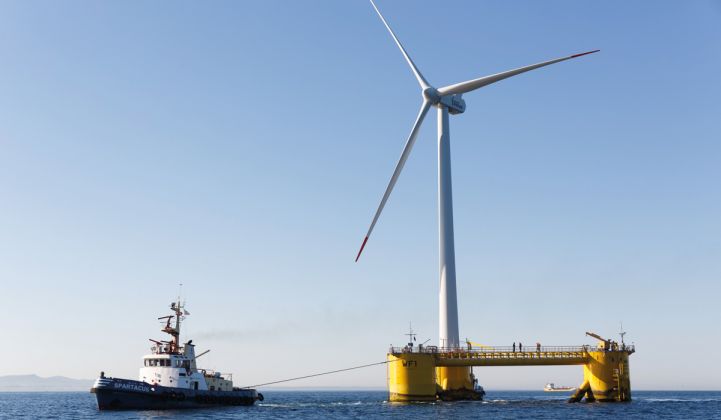Wind energy may have achieved one of its most significant landmarks ever with WindEurope’s announcement that floating offshore turbine technology has “come of age.”
WindEurope, which represents the interests of the most advanced offshore wind markets in the world, last month claimed a “breakthrough pipeline of projects” proved floating turbine designs had achieved technological maturity.
“Floating offshore wind is no longer consigned to the laboratory: It’s a viable technology ready to be rolled out on an industrial scale,” said the industry body in a recent press release.
WindEurope expects 298 megawatts of floating offshore wind projects to be commissioned between 2017 and 2021, starting with this year’s 30-megawatt Hywind Scotland wind farm, which is being built by Statoil and Masdar.
By 2030, MAKE Consulting, which is owned by GTM’s parent company Wood Mackenzie, predicts around 4 gigawatts of floating offshore capacity will have been installed worldwide.
This is a drop in the ocean compared to the almost 1,260 gigawatts of wind capacity that the Global Wind Energy Council expects to see installed by 2030, under its most conservative forecast.
Long-term, though, MAKE managing consultant Michael Guldbrandtsen said floating offshore could come to dominate the wind industry. "First of all, offshore wind is in a very good position to out-compete onshore wind, at least in some of the key offshore markets," he commented.
"And if we look at offshore wind, I also think that in the long term, sometime post-2030, we definitely see floating wind has the potential to play a bigger role than bottom-fixed foundations in some markets,” he said.
“When this is going to be the case is difficult to say and will depend on progress when it comes to cost reductions," Guldbrandtsen added.
Based on figures from the Taiwanese Ministry of Foreign Affairs and the U.K.-based Carbon Trust, WindEurope estimates there is potential for 4,000 gigawatts of floating offshore wind in Europe, 2,450 gigawatts in the U.S., 500 gigawatts in Japan and 90 gigawatts in Taiwan.
In Europe and Japan, 80 percent of all offshore wind resource is in waters beyond 60 meters in depth, noted WindEurope in its Floating Offshore Wind Vision Statement last month. In the U.S., the figure is 60 percent.
Dr. R.V. Ahilan, group director of renewables advisory and energy technology at LOC Group, a marine engineering consultancy, said: “As a technology, [floating wind] has certainly come of age. In terms of commercialization, I believe it has some time to run.”
Achieving a commercial scale of several hundreds of megawatts' worth of production capacity would still be challenging, he said. One hurdle is that there is no consensus on what kind of floating substructure should be used for the turbines.
Currently, WindEurope lists four substructure designs for floating offshore wind.
The spar buoy design planned for Hywind and the semi-submersible platforms slated for the 10-megawatt Dounreay Trì project next year are considered to have a technology readiness level of more than eight, meaning they have been qualified through tests and demonstrations.
A third design, the barge, is expected to surpass a technology readiness level of eight this year, with the fourth configuration, called a tension leg platform, following in 2018. It is still unclear which of these will be best suited to the upcoming generation of mega-turbines, though.
“The size of turbines is rapidly increasing, with MHI Vestas currently proposing 9.5 megawatts, and I believe by early to mid-2020s we will be at 15 or more,” Ahilan said.
“That plays beautifully into reducing the numbers of floating foundations and building foundations that are very large,” he said.
Another issue is how quickly floating offshore wind will be able to slide down the cost curve. There is some debate about this.
A study released last year by the International Energy Agency forecasted a median cost reduction of 38 percent by 2050, and a more optimistic prospect of up to 53 percent, which was identical to the most aggressive forecasts for onshore and fixed-bottom offshore technologies.
What is clear, if the onshore and fixed-bottom offshore experience is anything to go by, is that floating wind may not take long to become competitive. And then the sky is the limit. “The real estate that will become available will be in the thousands of gigawatts,” said Ahilan.



